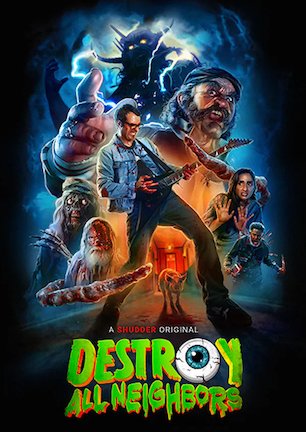Studio: Image Entertainment
Director: Jason William Lee
Writer: Jason William Lee
Producer: Dalj Brar
Stars: Debs Howard, Danny Zaporozan, Behtash Fazlali, Ian Collins, Marina Pasqua, Kylee Bush, Johnny Gillich, Robert Leaf, Gary Starkell, Tatyana Forrest, Jerome Velinski, Patrick Gaites
Review Score:
Summary:
Six friends celebrating the Fourth of July at an island cabin are turned into cannibals by a clandestinely engineered drug.
Review:
Some horror film fans are sick of “found footage.” Others are burnt out on post-apocalyptic dystopias. Personally, I’ve hit my current tolerance limit for premises that start with a group of friends on a remote cabin getaway filled with shifty locals, party montages, and no cellphone service, among other clichés.
That’s the wrong foot that sets off “The Evil in Us” on well-trod ground. Even though they are conspicuously Canadian, three couples are headed to a secluded island outside of Seattle to celebrate the Fourth of July. After a boat escort by a grizzled guide who seems none too pleased about the twentysomethings temporarily taking over, the sextet ignites a few fireworks, a campfire, and their libidos as festivities get underway.
What no one yet realizes is that the cocaine going up their noses contains a neurotropic virus engineered to turn humans feral (more on that in a minute). “The Evil in Us” sets itself up as a standard slasher given the routine groundwork laid. But it trades in for different tropes when the movie essentially becomes a zombie flick that has the friends facing a “28 Days Later”-like infection. Transformed into ravenous cannibals, a fight for survival ensues as everyone begins biting one another during gory bouts of mindless madness.
“The Evil in Us” might fare fine if that were the sole meal on its plate. Except the film weirdly tacks on two side stories that tie into the party arc by the end, but seem like unrelated asides while playing in parallel to the primary plot.
The first involves a bearded yet babyfaced detective. Exchange his suit and tie for a visor and apron and you’d have an infinitely easier time believing him as a Boston Market cashier than someone seasoned in law enforcement.
The detective investigates an apartment from the opening scene where two butchered bodies are found alongside a mutilated sole survivor. Adding some kind of urgency to the storyline appears to be the idea here, as the detective ends up in a race against time to prevent new murders on the island by figuring out what happened here first. But because it isn’t clear how he connects until well into the movie, that sense of suspense never comes.
Another funny thing is that the script doesn’t realize how everyone he interacts with actually does the detecting. His nondescript partner comes up with the clue that ties two key names together. A forensic examiner figures out what is really going on with the tainted coke. The detective is less a character and more a mere vessel for funneling exposition to initiate an unnecessary action during the climax.
SMALL SPOILER
The second side story involves the virus’ origin. Scattered scenes show an old man overseeing an underground project where bad actors become unwilling participants in his cannibal cocaine experiments. This old man is eventually revealed to be a Texas senator who, from what I could gather, manufactured this epidemic in a political maneuver to shame the executive branch for its ineffectual war on drugs. Even for a muah-ha-ha’ing movie villain, this has to be among the most improbably idiotic plots anyone could concoct to become United States president.
END SPOILER
Then there is some nonsense about this senator cofounding the Tea Party movement, along with clips from faux Fox News shows where people take bipartisan sides on the in-movie story. Errant political commentary is far from the only thing that doesn’t fit in the film, though this particularly bizarre bit really comes from left field with a “wha huh?”
Also, the three men and three women at the cabin don’t feel the full effects of transformation until 50 minutes into a 90-minute runtime. A viewer has to be way into their backstories of who used to sleep with who and who wants to sleep with who now to have any interest at all in the boring buildup.
Chopping a trio of plain plotlines into one overall narrative isn’t enough of a distraction tactic to hide how predictably rote all three are. Writer/director Jason William Lee may have thought this approach would put a fresh feel on his film. But the ho-hum sum isn’t greater than its cut-and-pasted parts. “The Evil in Us” is a whole lot of “been there, done that, didn’t care enough to bother picking up the t-shirt.”
NOTE: There is a mid-credits scene.
Review Score: 35







There’s a 2010s indie horror vibe running through “Descendent,” which I mean in the most complimentary manner possible.